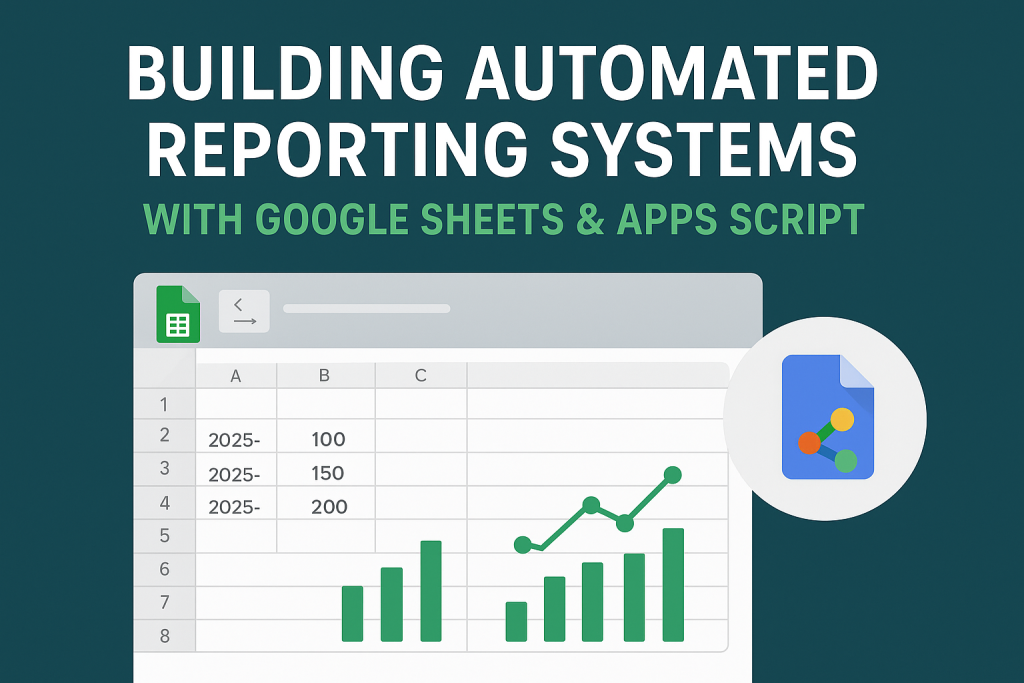
1. Introduction
In today’s fast-paced world, businesses, educators, and analysts all rely on data to make informed decisions. The problem is that raw data alone is rarely useful — it needs to be collected, cleaned, analyzed, and presented in a clear, actionable format.
Traditionally, this involves manual reporting: downloading CSV files, cleaning them in Excel or Google Sheets, creating pivot tables and charts, and emailing them to stakeholders. This is time-consuming, repetitive, and prone to human error.
The good news? With Google Sheets and Google Apps Script, you can automate the entire process — from collecting the data to distributing the final report — for free.
This guide will walk you through everything you need to know to build your own automated reporting system using Google’s tools. By the end, you’ll have the skills to create:
- Self-updating dashboards
- Automated PDF and email reports
- Data pipelines that pull from APIs and databases
- Scheduled processes that run without manual input
2. Understanding the Core Concepts
What is Google Apps Script?
Google Apps Script is a JavaScript-based cloud scripting language that lets you extend Google Workspace apps like Sheets, Docs, Drive, and Gmail. You can:
- Automate repetitive tasks
- Create custom menus and functions
- Connect Google Sheets to APIs
- Schedule scripts to run automatically
Think of Apps Script as a programmable remote control for your Google account.
Why Google Sheets for Automation?
- Cloud-based: Access from anywhere
- Collaboration: Multiple users can work on the same report
- Integration: Works seamlessly with other Google Workspace apps
- APIs: Can pull/push data from almost any service
3. Why Automate Reports?
If you’re spending hours each week compiling reports, you’re wasting valuable time. Automation solves this.
Benefits:
- Save Time – Hours of work reduced to seconds.
- Reduce Errors – No more broken formulas or miscopied cells.
- Consistency – Every report follows the same structure.
- Scalability – Handle more data without more effort.
- Real-Time Updates – Always have the latest data.
Example use cases:
- Sales performance dashboards
- Website traffic analytics
- Inventory monitoring
- Social media performance tracking
- Project status updates
4. Designing Your Reporting Workflow
Before writing code, outline your reporting pipeline:
- Data Collection – Where does the data come from? (API, form, spreadsheet, database)
- Data Cleaning – Remove duplicates, fix formatting
- Data Analysis – Create KPIs, pivot tables, and charts
- Report Creation – Format results for readability
- Report Distribution – Email, PDF, Slack, or a dashboard
- Scheduling – Automate how often it runs
5. Preparing Your Google Sheet
A well-structured sheet is key to automation.
Example:
- Sheet1: Raw Data
- Sheet2: Cleaned Data
- Sheet3: Dashboard
Best practices:
- Use clear column headers (avoid spaces)
- Keep one dataset per sheet
- Avoid merged cells in data sheets
- Use consistent date formats
Sample dataset (Raw Data):
| Date | Product | Quantity | Price | Region |
|---|---|---|---|---|
| 2025-01-01 | Widget A | 5 | 20 | East |
| 2025-01-02 | Widget B | 3 | 15 | West |
6. Getting Started with Google Apps Script
Opening the Script Editor
- Open your Google Sheet
- Click Extensions > Apps Script
- You’ll see an online code editor
Your First Script
javascriptCopyEditfunction createReportHeader() {
var sheet = SpreadsheetApp.getActiveSpreadsheet().getSheetByName("Dashboard");
sheet.getRange("A1").setValue("Monthly Sales Report");
sheet.getRange("A1").setFontWeight("bold").setFontSize(16);
}
Click ▶ Run to execute the function.
7. Automating Data Import
Import from Another Google Sheet
javascriptCopyEditfunction importDataFromSheet() {
var sourceSS = SpreadsheetApp.openById("SOURCE_SHEET_ID");
var sourceData = sourceSS.getSheetByName("Data").getDataRange().getValues();
var targetSheet = SpreadsheetApp.getActiveSpreadsheet().getSheetByName("Raw Data");
targetSheet.clearContents();
targetSheet.getRange(1, 1, sourceData.length, sourceData[0].length).setValues(sourceData);
}
Import from CSV URL
javascriptCopyEditfunction importCSVFromUrl() {
var url = "https://example.com/data.csv";
var response = UrlFetchApp.fetch(url);
var csvData = Utilities.parseCsv(response.getContentText());
var sheet = SpreadsheetApp.getActiveSpreadsheet().getSheetByName("Raw Data");
sheet.clearContents();
sheet.getRange(1, 1, csvData.length, csvData[0].length).setValues(csvData);
}
8. Data Cleaning & Transformation
javascriptCopyEditfunction cleanData() {
var sheet = SpreadsheetApp.getActiveSpreadsheet().getSheetByName("Raw Data");
var data = sheet.getDataRange().getValues();
var cleaned = [];
for (var i = 1; i < data.length; i++) {
var row = data[i];
// Remove empty rows
if (!row[0]) continue;
// Fix date format
row[0] = new Date(row[0]);
cleaned.push(row);
}
var cleanSheet = SpreadsheetApp.getActiveSpreadsheet().getSheetByName("Cleaned Data");
cleanSheet.clearContents();
cleanSheet.getRange(1, 1, cleaned.length, cleaned[0].length).setValues(cleaned);
}
9. Generating Summary Reports
Creating a Pivot Table with Apps Script
javascriptCopyEditfunction createPivotTable() {
var ss = SpreadsheetApp.getActiveSpreadsheet();
var sheet = ss.getSheetByName("Dashboard");
sheet.clear();
var range = ss.getSheetByName("Cleaned Data").getDataRange();
var pivotTableSheet = sheet.getRange('A1').createPivotTable(range);
pivotTableSheet.addRowGroup(1) // Group by Product
.addPivotValue(2, SpreadsheetApp.PivotTableSummarizeFunction.SUM); // Sum of Quantity
}
10. Adding Charts Automatically
javascriptCopyEditfunction createChart() {
var sheet = SpreadsheetApp.getActiveSpreadsheet().getSheetByName("Dashboard");
var range = sheet.getRange("A1:B10");
var chart = sheet.newChart()
.setChartType(Charts.ChartType.COLUMN)
.addRange(range)
.setPosition(5, 5, 0, 0)
.build();
sheet.insertChart(chart);
}
11. Sending Automated Reports via Email
Email as PDF
javascriptCopyEditfunction sendReportAsPDF() {
var ss = SpreadsheetApp.getActiveSpreadsheet();
var url = ss.getUrl().replace(/edit$/, '') + 'export?format=pdf';
var options = {
headers: {
"Authorization": "Bearer " + ScriptApp.getOAuthToken()
}
};
var response = UrlFetchApp.fetch(url, options);
var blob = response.getBlob().setName("Monthly_Report.pdf");
MailApp.sendEmail({
to: "manager@example.com",
subject: "Monthly Sales Report",
body: "Please find the attached report.",
attachments: [blob]
});
}
12. Scheduling Automation
You can set time-driven triggers so scripts run automatically.
Steps:
- Go to Apps Script Editor
- Click the clock icon (Triggers)
- Choose your function (e.g.,
sendReportAsPDF) - Select schedule (daily, weekly, monthly)
13. Integrating External APIs
Example: Fetch live stock prices
javascriptCopyEditfunction getStockPrice() {
var url = "https://api.example.com/stock?symbol=AAPL";
var response = UrlFetchApp.fetch(url);
var data = JSON.parse(response.getContentText());
var sheet = SpreadsheetApp.getActiveSpreadsheet().getSheetByName("Dashboard");
sheet.getRange("B2").setValue(data.price);
}
14. Error Handling
javascriptCopyEditfunction safeRun() {
try {
importDataFromSheet();
cleanData();
createPivotTable();
createChart();
sendReportAsPDF();
} catch (e) {
Logger.log("Error: " + e.message);
MailApp.sendEmail("admin@example.com", "Report Automation Failed", e.message);
}
}
15. Security Best Practices
- Use bounded scripts tied to the Sheet
- Minimize script permissions
- Store API keys in PropertiesService
- Avoid sharing sensitive Sheets publicly
16. Real-World Example: Monthly Sales Automation
- Data imported daily from Google Forms
- Cleaned automatically
- Pivot table + chart generated
- PDF emailed to stakeholders on the 1st of each month
- Zero manual steps
17. Troubleshooting
Common issues:
- Script timeout (limit: 6 minutes)
- API quota exceeded
- Sheet formatting issues
- Missing permissions
18. Conclusion
With Google Sheets and Apps Script, you can turn any repetitive reporting process into a hands-off, fully automated system. Once set up, these systems run in the background — giving you back hours of your time and ensuring data accuracy.
The best part? It’s free, cloud-based, and requires nothing more than your Google account.


Leave a Reply